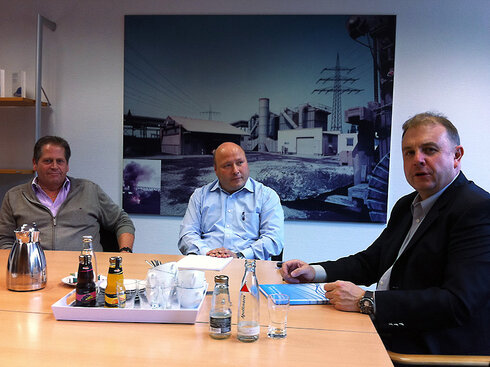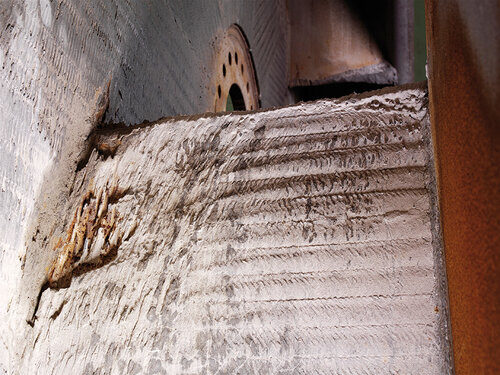How do the manufacturers of equipment for the cement industry see the subject of service, repair and maintenance? ZKG spoke to Peter Herrmann, head of the Industrial Fans Division at Ventilatorenfabrik Oelde, his colleague, Frank Kolbe, Sales Manager for After Sales Service, and Klaus Wilkes, Head of Customer Service.

ZKG: What is Venti’s service and repair strategy? Or, to use the “New German” term, your strategy for “Maintenance, Repair & Operations”, MRO?
Herrmann: That description is really not a bad one, although it’s not yet part of our everyday vocabulary. But it does include the three routes that make up our service activities: in the first place, the customer approaches us, because he has a problem – performance, wear, caking, vibration, and so on. This is the easier route for us.
Our second approach is a systematic and proactive one, in which our service department monitors specific Venti projects or installations. My colleague here, Frank Kolbe, notes where in the world and to what cement plant we have supplied process fans, and then contacts the end customer, with the aim of finding out how our products are performing. The guarantee has generally expired by this time, and then there is a chance of ascertaining a need for spares.
The third route, like the second, is a Venti initiative, but with the important difference that it doesn’t involve our own equipment, but third-party brands, instead. Variations in quality come to light in heavily loaded fans, in particular, and we and our experts assist in eliminating them. It sometimes happens that suppliers of all-in systems, and sometimes individual plant operators, approach us for this.
There are also a range of different options for activity – on the one hand, we have the “classical” spare parts business: many machines have to run with high reliability to assure plant operation, and then it’s a good idea, for example, to stock spare rotors, so that any failure can be eliminated very quickly and production continued. The delivery times for large rotors are always very long, and no one in this industry can afford to wait months for a vital spare.
Another field for us is actual repair. Machine wear after a few years of operation in a cement plant is usually so severe that the fans have to be overhauled. Some customers have the overhaul done on-the-spot by our teams, while others return their worn impellers to our workshops, which is a cheaper solution for the customer but, of course, also confronts him every time with the question of a replacement impeller until the repair is completed.

ZKG: What fan parts most frequently wear or need replacement?
Herrmann: The problem with all fan impellers, whatever their origin, is wear protection, usually with exposure to higher levels of particulates than planned in the design. This causes rotor erosion, which we repair with welding. In some cases, we also apply wear protection superior to the fan’s original wear protection system. Then the fans have to be balanced again.
Kolbe: We can also do the hardfacing on site, with the fan installed and, after armouring, we can also perform the balancing in situ. When fans are returned to our works, the customer receives a cost estimate listing the worn items and the time needed for repair or refurbishing. The customer, of course, checks through this, gives us the go ahead, and we start work.
Wilkes: My people then, so to speak, follow the overhauled components back to the plant and reinstall them at the site. The machines usually need rebalancing and realignment of their bearings, so it’s generally a good idea to send a specialist to the plant to do this work on the spot.
Herrmann: Another item associated with maintenance is the desire of many plant operators for greater performance from their existing machines – usually with as little expense as possible. They like, wherever possible, to retain the existing fan housings, since their dimensions are already integrated into the plant layout. For instance the customer then wants to install a more efficient impeller, or an impeller with better wear protection.
Kolbe: Energy-efficiency is also an important factor here, and customers frequently ask us for ideas on improving it. The power costs for fan drive motors can be heavy, and savings of 10 % amount to quite a sum across a year of operation. As always, however, it is necessary to integrate new components into the existing system.
Herrmann: I can think of a good example of this, one which we have not yet properly measured and that therefore still has a few question marks surrounding it: there is a grinding mill at a German cement plant from the early 1990s. It includes one of our fans which is monitored for its aerodynamic and energy performance. We contacted the operator and told him that he could save up to 300 kWh per hour just by making minor improvements to the existing housing and installing a new impeller – although that, of course, was only a good estimate! In other words: an investment like this would pay off for the customer in as little as around six months. This kind of business will certainly grow in the cement industry in future. There are not so many new cement plants being built these days, the industry’s main concern is more that of achieving ever more reductions in the costs of clinker production – and energy consumption is a very important factor here. All cement producers are now extremely receptive to energy-saving solutions.

ZKG: Do you have a special production route for MRO parts, or are they all diverted from machine production?
Herrmann: No, we don’t have a special production line for spare parts, they all come from our ongoing production process, there are no parallel production lines. And – with the exception of the small machines – we don’t practice mass or series production, all of our large fans – and they are what we are talking about in the cement industry, of course – are one-offs and are built individually for each specific project. The applications for our machines are so diverse and broad that no one fan is really exactly the same as any other – it’s only very rarely that we build the same fan twice.
Kolbe: It would also be a great coincidence if we had an identical item for another customer, it’s pretty unlikely. Each customer’s needs are generally so specific that we effectively always do all the calculations, design and production from new.
ZKG: Who is responsible for doing this?
Herrmann: It’s performed for each specific project by our Service/Spares Department. The drawing office or the corresponding Marketing/Sales colleagues are consulted if any technical calculations are necessary. The information is passed back to the service team, and the customer receives a corresponding quotation or proposals.
ZKG: In developing new products, do you also have a Plan B to cover any weaknesses in the product?
Herrmann: Quite a lot has been done here in the last few years, particularly as far as wear protection materials are concerned. Tungsten carbides are coming into greater use, they have service lives six to seven times those of the conventional chromium carbide material. They are relatively expensive, though. There are also new production methods, some of which we developed ourselves, often on a trial and error basis. By agreement with the individual customer, we have, for example, installed impellers with blades fitted with several different anti-wear materials in a number of plants, and this enabled us to assess effectively the durability of a range of materials. We have also performed blasting tests at the Clausthal University of Technology using extremely aggressive media, such as sinter dust from the steel production process, in order to obtain information on service lives for the various anti-wear materials. All this has resulted in our abandoning the enormous plate thicknesses used earlier, and thus restoring our competitiveness. One problem here is, however, that welding on of composite armouring materials causes a loss in the strength of the basic blade material, so that we have to select high thicknesses for the underlying plate. Laser welding has advanced to such an extent that the penetration depth is now less, with the result that the parent plate loses less of its strength. In short, thinner plate, better welding technology and harder armouring now achieve significantly higher service lives than were previously possible even with a much larger input of material. Weight savings of up to 10 %, at a rough estimation, are already possible and that, on a moving part like an impeller, is a worthwhile amount.
Nowadays, it’s generally true to say that the weaknesses are not in the material used or the design of the fan, but in the service environment. Take the special case of kiln fans, for example, where the increasing use of alternative fuels more and more frequently causes severe caking which are difficult to remove. This results in vibration, because the balance of the impeller hois disturbed, and then the vibration can cause bearing damage. In many cases, we are unable to quantify this problem on new projects, because we don’t have the vital information from the customer: What are the characteristics of the particulates? What are the operating conditions? What fuel or mix of fuels is used? We’re working on solutions to permit cleaning and/or balancing during operation, and there are various applications for these. Even now, we build these critical fans ready-prepared for automatic balancing.
ZKG: In that case, wouldn’t a coating be the best solution – something like the “lotus effect”, which repels everything?
Herrmann: It would be an absolute dream if that were possible! We’ve tried practically everything – polishing, coating, you name it – but there’s no universal solution! Too hot, or the particulates are too abrasive ... let’s face it, a cement plant is not a chocolate factory! The maintenance staff use high-pressure cleaners and mechanical lances when they clean the impellers, and no coating will resist that!
ZKG: How do you handle fan operators’ information on why a particular part might have failed? Is the replacement part made specifically to meet the user’s feedback?
Herrmann: We supply most of our process fans via plant engineering companies, and they enquire for a certain specification at the order stage, and don’t tell us about any specific problems at the plant or in the region. In some cases, we don’t even get dust analyses, and that alone entails a certain risk for us. We have our know-how and experience, and of course we know that you need to take account of this or that type of dust in Saudi Arabia, but in the Gulf, or in some areas of North Africa, you need to watch out for other dust types or the raw meal, because they´re abrasive or they may have a high quartz content. This is information that we don’t get necessarily from the plant builders. They just say, “I want a kiln fan for one million cubic metres at such-and-such a pressure and 60 g dust”. And that’s it – no mention of the fuel, or anything else!
Kolbe: We have experience that we can incorporate into these projects, we can, for example, suggest to the customer that it might be better to choose a more wear-resistant fan for specific regions or specific applications, or a fan more resistant to caking, rather than one with a higher efficiency. It’s a similar situation with the ever increasing use of secondary fuels – the material can be more homogenous or less homogenous, depending on exactly what is being combusted. The composition changes continuously and no one knows in advance, when the order is placed, what fuel will be used a year after commissioning. And what will follow up – used tyres? Plastic?
Herrmann: We now have a current case in which a particular secondary fuel is used. Here, the raw meal sticks to the impeller as if it were a tile adhesive. It can only be removed again purely mechanically, or you’ll cause corrosion on other components.
If we hear from a customer, or via our service staff, that the customer wants to operate at higher temperatures, on the other hand, we naturally react immediately and choose a material that will withstand the higher temperatures. The customer’s wishes are our focus, and we think about how we can help him. The ideal situation would be that both sides contribute their experience and information to the new product or component. It’s difficult enough, in fact virtually impossible, to simply go into a cement plant and say to the customer, “So tell me a bit about your experience with these fans” – only very few operators are willing to take the time for that. You generally hear nothing – which, of course, is also a good sign, because it means there are no problems and everything’s running smoothly.
ZKG: How quickly can you complete a repair or service job? And where do the service employees come from?
Wilkes: They’re our own people, everything is controlled and co-ordinated from Oelde. We try to ensure that our service technicians can arrive anywhere in the world within 24 hours, but these people are unfortunately not always immediately available, and then it can take a little longer. We usually manage to meet the 24 hours target, though.
Herrmann: Yes, perhaps with the notable exceptions of Christmas and Easter! But then we have our 24 h/365 day service hotline, available day and night, and with the number stated on every product. That gives the customer confidence. Our statistical analysis showed that there are only three or four real emergency calls each year.
Wilkes: A plant out of action is, of course, a problem, but it’s the exception, rather than the rule. And we can be on site relatively quickly, provided no visa is needed. And even then, many of our service technicians have a whole collection of valid visas, filling up several passports.
ZKG: And how about remote diagnosis at Venti?
Herrmann: We’ve only done it in one region up to now, in the cement plants between Beckum, Erwitte and Paderborn, in Germany. It was agreed with the customers, and enabled us to monitor the fans during operation. The response was only half-hearted, though, some of them didn’t want to let us take a look, and others only on request. I personally don’t see any great future in this – the parameters and the volumes of data are simply too basic: only volumetric flow, speed, bearing temperatures and bearing vibration. It’s too little, and it doesn’t really produce great benefits.
Wilkes: It’s a different picture if you look at our plant engineering division. We’ve already been able to solve one or two problems directly from Oelde, by dialling into the program – someone pressing the wrong button can sometimes be enough to cause the hitch. We reset the system from Oelde, and it generally starts to run properly again.
ZKG: What qualifications do your service technicians need?
Herrmann: We need electricians for this work, but with the necessary additional qualifications, of course. Programming abilities are also useful. Service technicians are generally urgently sought – with half-page advertisements in national newspapers, for example. One of the reasons is that this job is usually extremely demanding and strenuous – one of our technicians once showed me a map of where he’d been in the world after only four years at Venti: there were pins spread all around the globe, and clustered densely together in a lot of cases.
Wilkes: The biggest workload is when the process starts up. The basic program already exists, but you have to be on site to make changes and modifications if the customer wants to open a valve three seconds earlier or close another one four seconds later – fine-tuning, in other words. Setting times and adjusting parameters. This is also all done by people from Oelde. In India, for example, the German technician is on site as a supervisor and has a dozen Indians who perform the necessary work according to his instructions. Then he only has to check dimensional accuracy, and make sure that everything is running as required.
ZKG: Many thanks for an interesting and informative interview.

关注万迪欧德公众号

万迪欧德抖音号
Copyright © 2022-2023 Venti Oelde (Jiangsu) Air Handling Equipment Co. Ltd All Right
备案号:ICP 2023002554 技术支持:镁诚科技